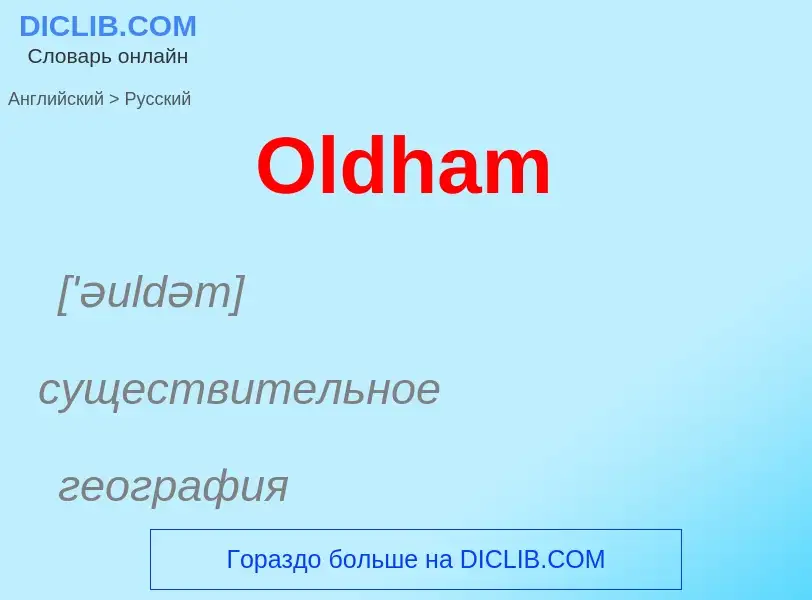Tradução e análise de palavras por inteligência artificial ChatGPT
Nesta página você pode obter uma análise detalhada de uma palavra ou frase, produzida usando a melhor tecnologia de inteligência artificial até o momento:
- como a palavra é usada
- frequência de uso
- é usado com mais frequência na fala oral ou escrita
- opções de tradução de palavras
- exemplos de uso (várias frases com tradução)
- etimologia
Oldham - tradução para russo
['əuldəm]
существительное
география
г. Олдем
['kʌpliŋ]
общая лексика
спаривание
сопряжение
связь
поясница
поясничный отдел (у четвероногого животного)
взаимодействие
связывание
(соединительная) муфта
связность
сцепка
генетика
сцепление
строительное дело
соединительная муфта
соединительная деталь
зажим
ниппель
соединение
нефтегазовая промышленность
сцепление, сочленение
соединительный фланец
муфта
соединительная втулка
фитинг для механического соединения двух концов троса
кулачковая муфта
свинчивание (штанг, труб)
сейсмология
проникновение (из одной среды в другую)
существительное
общая лексика
соединение
сцепление
стыковка
соединение (космических кораблей)
совокупление
спаривание
сопряжение (биохимических процессов)
техника
муфта
сопряжение
электротехника
связывание контуров
физика
взаимодействие
связь
биология
сцеплённость (признаков с полом)
общая лексика
шестеренная муфта
Definição
Wikipédia

Oldham is a town in Greater Manchester, England, it lies amongst the Pennines on elevated ground between the rivers Irk and Medlock, 5 miles (8.0 km) southeast of Rochdale and 7 miles (11.3 km) northeast of Manchester. It is the administrative centre of the Metropolitan Borough of Oldham, which had a population of 237,110 in 2019.
Within the boundaries of the historic county of Lancashire, and with little early history to speak of, Oldham rose to prominence in the 19th century as an international centre of textile manufacture. It was a boomtown of the Industrial Revolution, and among the first ever industrialised towns, rapidly becoming "one of the most important centres of cotton and textile industries in England." At its zenith, it was the most productive cotton spinning mill town in the world, producing more cotton than France and Germany combined. Oldham's textile industry fell into decline in the mid-20th century; the town's last mill closed in 1998.
The demise of textile processing in Oldham depressed and heavily affected the local economy. The town centre is the focus of a project that aims to transform Oldham into a centre for further education and the performing arts. It is, however, still distinguished architecturally by the surviving cotton mills and other buildings associated with that industry.
In the 2011 United Kingdom census Oldham Built-up area subdivision, as defined by the Office for National Statistics, had a population of 96,555 and an area of 1,687 hectares (6.51 sq mi), giving a population density of 57.2 inhabitants per hectare (14,800/sq mi), while the Borough of Oldham had a population of 224,897, an area of area of 14,236 hectares (54.97 sq mi), and a population density of 15.8 inhabitants per hectare (4,100/sq mi).


![The Blue Coat School]] is one of Oldham's oldest schools, dating back to 1834. The Blue Coat School]] is one of Oldham's oldest schools, dating back to 1834.](https://commons.wikimedia.org/wiki/Special:FilePath/Blue coat0004.jpg?width=200)
![[[Boundary Park]] is Oldham's main sports stadium, and is used by [[Oldham Athletic A.F.C.]] [[Boundary Park]] is Oldham's main sports stadium, and is used by [[Oldham Athletic A.F.C.]]](https://commons.wikimedia.org/wiki/Special:FilePath/Boundary Park.jpg?width=200)
![The stained glass rotunda of The Spindles Town Square Centre, one of Europe's largest works in the medium, created by local artist [[Brian Clarke]] The stained glass rotunda of The Spindles Town Square Centre, one of Europe's largest works in the medium, created by local artist [[Brian Clarke]]](https://commons.wikimedia.org/wiki/Special:FilePath/Brian Clarke Spindles Oldham.jpg?width=200)
![The 409 to [[Rochdale]], pictured in Oldham's town centre. [[First Greater Manchester]] has its headquarters in Oldham, operating bus services throughout Greater Manchester. The 409 to [[Rochdale]], pictured in Oldham's town centre. [[First Greater Manchester]] has its headquarters in Oldham, operating bus services throughout Greater Manchester.](https://commons.wikimedia.org/wiki/Special:FilePath/Bus in Oldham.jpg?width=200)

![Werneth]]. Much of Oldham's housing stock is two-up-two-down rows of [[terraced house]]s, a reminder of its [[mill town]] history. Werneth]]. Much of Oldham's housing stock is two-up-two-down rows of [[terraced house]]s, a reminder of its [[mill town]] history.](https://commons.wikimedia.org/wiki/Special:FilePath/Fredrick Street, Werneth, Oldham.jpg?width=200)
![Platt's Works]], Oldham, 1900 Platt's Works]], Oldham, 1900](https://commons.wikimedia.org/wiki/Special:FilePath/MandK Industrial Revolution 1900.jpg?width=200)

![Oldham's irregularly constructed [[built environment]] is characterised by its red-brick [[cotton mill]]s and surrounding [[terraced house]]s. Oldham's irregularly constructed [[built environment]] is characterised by its red-brick [[cotton mill]]s and surrounding [[terraced house]]s.](https://commons.wikimedia.org/wiki/Special:FilePath/Mill & Church - Oldham.jpg?width=200)
![Stained-glass skylight of the Spindles Town Square Centre by local artist [[Brian Clarke]], inspired by Oldham-born composer William Walton's ''Orb and Sceptre Coronation March''. The work is one of three interrelated windows, among the largest stained-glass windows in Europe, designed and made between 1990 and 1993. Stained-glass skylight of the Spindles Town Square Centre by local artist [[Brian Clarke]], inspired by Oldham-born composer William Walton's ''Orb and Sceptre Coronation March''. The work is one of three interrelated windows, among the largest stained-glass windows in Europe, designed and made between 1990 and 1993.](https://commons.wikimedia.org/wiki/Special:FilePath/Modern abstract stained glass Small Mall rooflight of Spindles Town Square Shopping Centre Oldham, by Brian Clarke (1993).jpg?width=200)

![civic centre]] is the [[Metropolitan Borough of Oldham]]'s centre of local governance. civic centre]] is the [[Metropolitan Borough of Oldham]]'s centre of local governance.](https://commons.wikimedia.org/wiki/Special:FilePath/Oldham Civic Centre.jpg?width=200)
![[[Oldham College]] is a centre for [[further education]]. [[Oldham College]] is a centre for [[further education]].](https://commons.wikimedia.org/wiki/Special:FilePath/Oldham College.jpg?width=200)

![urbanised]]. urbanised]].](https://commons.wikimedia.org/wiki/Special:FilePath/Oldham From Glodwick.png?width=200)
.jpg?width=200)
![A panorama of Oldham looking from [[Hartshead Pike]] toward the north-west.}} A panorama of Oldham looking from [[Hartshead Pike]] toward the north-west.}}](https://commons.wikimedia.org/wiki/Special:FilePath/Oldham panorama (crop).jpg?width=200)
![old town hall]], built in 1841, following its conversion into a multiplex cinema old town hall]], built in 1841, following its conversion into a multiplex cinema](https://commons.wikimedia.org/wiki/Special:FilePath/Parliament Square and the Old Town Hall, Oldham (geograph 6003292).jpg?width=200)


![Metrolink]] tram running through Union Street, on the Oldham town centre line opened in January 2014. Metrolink]] tram running through Union Street, on the Oldham town centre line opened in January 2014.](https://commons.wikimedia.org/wiki/Special:FilePath/Tram on Union Street, Oldham, looking west, geograph-3808797-by-Alan-Murray-Rust.jpg?width=200)


![An elastic coupling (for connecting a [[windsurfing]] sail rig to the board) An elastic coupling (for connecting a [[windsurfing]] sail rig to the board)](https://commons.wikimedia.org/wiki/Special:FilePath/Windsurfing equipment 2008 46.jpg?width=200)

 - Angular Misalignment.jpg?width=200)


